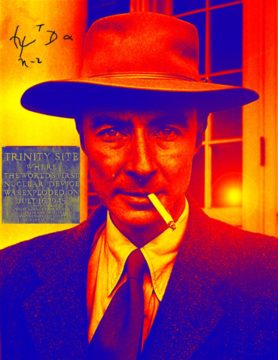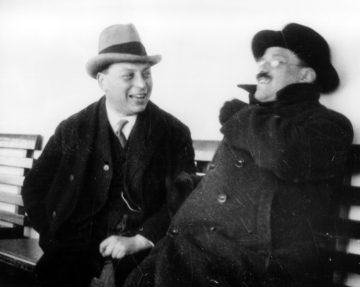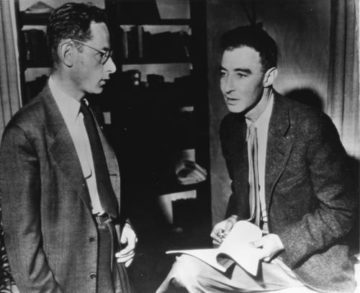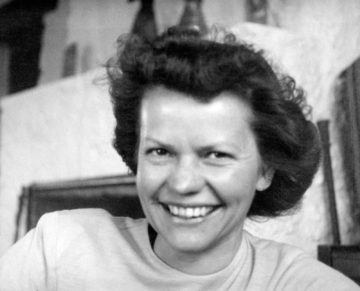by Ashutosh Jogalekar
This is the fourth in a series of posts about J. Robert Oppenheimer’s life and times. All the others can be found here.

Robert Oppenheimer, said Hans Bethe, “created the greatest school of theoretical physics America has ever known.” Coming from Bethe, a physicist of legendary stature who received the Nobel Prize for figuring out what makes the stars shine and who published papers well into his nineties, this was high praise. Before Oppenheimer, it was almost mandatory for young American physics students to go to Europe to study at the feet of masters like Bohr or Born. After Oppenheimer brought back the fire from the continent, they only had to go to California to bask in its glow. Today, while Oppenheimer is most famous as the father of the bomb, it is very likely that posterity will judge his creation of the American school of modern physics as his most important accomplishment.
When he graduated from Göttingen with his Ph.D. in 1927, Oppenheimer’s reputation preceded him. He received ten job offers from universities like Harvard, Princeton and Yale. He chose to go to the University of California, Berkeley. There were two reasons that drew him to what was then a promising but not superlative outpost of physics far from the Eastern centers. Berkeley was, in his words, “a desert”, a place with enormous potential but one which did not have a flourishing tradition of physics yet. The physics department there had already hired Ernest Lawrence, an experimentalist who would become, with his cyclotron, the father of ‘big science’ in the country. Now they wanted a theorist to match Lawrence’s experimental acumen. Oppenheimer who had proven that he could hold his own with the most important physicists in Europe was a logical choice.
There was another reason Oppenheimer was drawn to Berkeley. The arrangement he made with Raymond Birge, the chairman of the physics department, was to split his time between Berkeley and the equally promising California Institute of Technology down the coast. Just like Birge was building up physics at Berkeley, Robert Millikan was building up physics at Caltech. Unlike Berkeley, Caltech had the best experimenters in the two fields that were then fashionable and exciting – cosmic rays and nuclear physics. The astute Oppenheimer, through his failed experimental adolescence in Rutherford’s lab, understood all too well how theory without experiment was barren. Caltech would provide him the grounding in experimental reality that flying in the upper reaches of theory at Berkeley would not.

Before Oppenheimer started his tenure in California, he applied for and received a National Research Council fellowship to study with two other European masters of the art – Paul Ehrenfest in Leiden and Wolfgang Pauli in Zurich. The fellowship was aimed at repairing some of the lack of rigor and gaps in his knowledge of physics. His choice of both mentors was apt; among physicists of their era, both Pauli and Ehrenfest were best known for being the severest critics. Pauli, affectionately called the “wrath of God” by his colleagues, was one of the most important theoretical physicists of the 20th century, contributing his name among other things to the ‘exclusion principle’ that underlies the construction of electron shells in the elements, and therefore all of chemistry. Unlike Oppenheimer who found his footing only in his late 20s, Pauli had started as a prodigy. When he was 19 he had published an authoritative, long article on relativity that drew praise from Einstein. As trenchant in his opinions as original in his ideas – he famously once called the ideas in a paper “not even wrong” – Pauli was enormously respected by both his teachers (Bohr, Sommerfeld, Born) and his colleagues, including his closest friend Heisenberg. Paul Ehrenfest, a warm, supportive physicist who sometimes suffered from bouts of depression, was even more liked and respected for his objective advice and keen interest in the welfare of young physicists.
Six weeks after arriving in Leiden, Oppenheimer astonished his colleagues who were not familiar with his facility with languages by delivering a lecture in Dutch. They affectionally christened him ‘Opje’, a nickname which became Americanized to ‘Oppie’ and stuck for a long time. He did some important work in statistical mechanics with Ehrenfest and then planned to study with Bohr, but Ehrenfest wisely cautioned him against it and sent him to Pauli. Ehrenfest realized, Oppenheimer recalled, that “Bohr with his largeness and vagueness was not the medicine I needed but that I needed someone who was a professional calculating physicist and that Pauli would be right for me…it was clear that he was sending me there to be fixed up.” To Pauli Ehrenfest wrote, “For the development of his scientific talents, Oppenheimer needs right now to be lovingly spanked in shape.” The spanking seems to have worked well; from Pauli and Ehrenfest Oppenheimer acquired rigor, and he was to have a deep respect for both men for the rest of his life.
Oppenheimer started as a professor at Berkeley in 1929. The next ten years or so, until he was drawn into the maw of the atomic bomb project, were arguably the happiest and most contented of his life. He could live the academic’s privileged life, working on the frontiers of physics. Offers from other places including Harvard refused to draw him away from the Golden State, where “the good California wine consoles for the hardness of physics and the poor powers of the human mind.”, as he wrote to his brother. The 1930s are filled with copious letters Oppenheimer wrote to Frank, then pursuing a degree in physics at Johns Hopkins, on the virtues of discipline, on physics and advice on romantic attachments. When the summers got too hot, he and Frank along with occasional students and colleagues could find relief at a cabin the brothers had purchased in the New Mexico Pecos wilderness in 1929 – the cabin’s name was “Perro Caliente”, Spanish for ‘hot dog’, the phrase uttered by Robert when he first saw it. The cabin was spare with no running water. Newcomers were taught how to ride, and the brothers slept under the stars.
Buttressed by a handsome trust fund and engrossed in his science, literature and poetry, Oppenheimer could afford to not worry about money and world events and surround himself in an ivory tower cocoon; owning no radio and subscribing to no newspapers, he claimed to have not heard of the world-changing 1929 stock market crash until several months after it happened. He acquired new interests and pursuits, most notably an interest in Sanskrit and the Bhagavad Gita that was to lead to his most publicly famous quote; he enjoyed the “sweet luxury of being taught” Sanskrit from Arthur Ryder, an austere Sanskrit scholar who headed a department of one at Berkeley.
Since Oppenheimer’s quote from the Bhagavad Gita – “Now I am become death, the destroyer of worlds” – has become such a central part of his public identity, it’s worth a digression to explore it in some detail. The most authoritative account of Oppenheimer and the Gita is by the historian James Hajiya. The Gita is essentially a long poem from the Hindu epic the Mahabharata. Its essence is an emphasis on doing your duty and not worrying about the fruits of your labor, enjoying the journey and the process for their own sake. Close to the end of his life, when Oppenheimer submitted a list of the ten books that most shaped his worldview to The Christian Century, the Gita made the list (others included Baudelaire’s Les Fleurs du Mal, T. S. Eliot’s The Wasteland and the Collected Works of Bernhard Riemann). It is tempting to think that the Gita might have profoundly and generally shaped his worldview, but the evidence does not support such an influence. His brother Frank said that he never really embraced any core tenets of Hinduism. More strikingly, the physicist Freeman Dyson who knew Oppenheimer well for twenty years told me once that not a single time during those twenty years did Oppenheimer mention anything at all about Hinduism or the Gita to him. Whatever the influence of the Gita was, it seems to have been one among many eclectic sources from which the polymath physicist drew inspiration.
Promising young physicists started to be drawn to Oppenheimer like moths to a flame. Between 1929 and 1945, Oppenheimer supervised the Ph.D. theses of twenty-nine students as well as numerous postdocs. This number included an astonishing sixteen Ph.D.s between just 1940 and 1943. Students flocked to him from all over the country. The speed of his thinking, the blue eyes and spare frame, the remarkable ability to speak in complete sentences, the chain smoking, the fondness for whipping up spicy dishes that would leave everyone gasping for breath, the knowledge of Sanskrit and poetry, the mastery of all of physics – they were mesmerized by all of it. It did not matter that his brilliance came with a sharp tongue and a withering impatience with people he considered less intellectually adept than himself. They acquired his mannerisms, his walk, his inflections – while speaking Oppenheimer made little pauses that sounded like “nim, nim” – and confidently drove with him each year to Caltech, not knowing where they were going to live. When Pauli was asked by a fellow physicist if there was any good theoretical physics in America, he replied, “Haven’t you heard of Oppenheimer and his nim nim boys?”. During a visit to Berkeley, Enrico Fermi – one of history’s greatest physicists – joked to his colleague Emilio Segre, “I am getting old and rusty, Emilio. I could not understand anything Oppenheimer and his pupils were saying. Only the last sentence cheered me up – “And this is Fermi’s theory of beta decay.”

Robert Serber, a young physicist from Philadelphia with a piercing mind who later become one of Oppenheimer’s closest confidants, was on his way to a research fellowship with physicist Eugene Wigner at Princeton when he heard Oppenheimer at a summer school at the University of Michigan. “His mind was so quick, his speech so fluent”, that Serber was awestruck. He straightaway drove to Princeton and had his fellowship changed to Berkeley. Other students who later became famous – David Bohm, Philip Morrison, Willis Lamb, Melba Phillips – followed. Philips was one of Oppenheimer’s first students and one of the very few women in those times to get a Ph.D. in physics. With Oppenheimer she discovered a new nuclear process called the Oppenheimer-Phillips process in which a deuteron (a combination of a neutron and a proton) donates its neutron to a target nucleus when it strikes it, ejecting a proton in the process.
With his students Oppenheimer made striking advances that established him at the forefront of physics and put American theoretical physics and Berkeley on the map. “Perhaps the most important ingredient Oppenheimer brought to his research was his exquisite taste.”, said Hans Bethe. “He always knew what the important problems were…he truly lived with those problems, struggling to solve them, and he communicated his concern to his group.” ‘Taste’ as evidenced by knowledge of the most important, foundational problems in physics had been largely absent in American theoretical physics until then, being the province of the Europeans; Oppenheimer broke this monopoly. Because of his wide interests he worked on a wide variety of topics – cosmic rays, nuclear physics, quantum electrodynamics, gravitational physics. For a pure theorist, he was also remarkably well-informed about experiments, often knowing the numbers and data better than the experimentalists. He and Ernest Lawrence became good friends – in spite of their opposite political sensibilities – with Oppenheimer often interpreting the data coming out of Lawrence’s giant cyclotrons. Among other accomplishments, Oppenheimer was the first one to point out the problem of infinities that was to lead to a major revolution in physics after the war. He was the first to point out that the positive particle that Dirac had postulated in his theory of the electron could not be the proton, as Dirac had proposed in a crisis of self-confidence. He rapidly worked through problems with his students, being sure of the physics but often making mistakes in the mathematics: “his physics was superb but his mathematics was awful”, remembered one student.
Oppenheimer’s greatest contribution to physics, one that showcased the complexity of his character, came in 1939. It was in a remarkable paper that was the first one to describe what we call black holes. In this paper Oppenheimer and his student Hartland Snyder noted all the essential aspects of black holes, including the event horizon, the difference between time as experienced by an external observer and one falling through the event horizon and the complete collapse of a star into what we now call a singularity. Many aspects of this paper are striking: it was part of a minor foray by Oppenheimer into the theory of relativity, one of only three papers that he published on the topic; it was written on the eve of the Second World War and was quickly overshadowed by other events and scientific developments; and most importantly, for a paper that turned out to be his most important contribution, it was one in which he showed absolutely no interest for the rest of his life. In a previous post I have written about this work and will have more to say about it later.
With all of Oppenheimer’s contributions and widespread intellectual talents, the outstanding question is why he never ascended to the highest echelons of physics, why he never won a Nobel Prize for instance. Looking at the roster of Nobel Laureates in the 1930s and 1940s, just to set a benchmark, it is clear that many of them, while being very competent physicists, were not equal to Oppenheimer in their insights and their oeuvre. Isidor Rabi who knew Oppenheimer as well as anyone, provided a fascinating, penetrating explanation that partly touches on Oppenheimer’s interest in Sanskrit:
“Oppenheimer was overeducated in those fields, which lie outside the scientific tradition, such as his interest in religion, in the Hindu religion in particular, which resulted in a feeling of mystery of the universe that surrounded him like a fog. He saw physics clearly, looking toward what had already been done, but at the border he tended to feel there was much more of the mysterious and novel than there actually was … he turned away from the hard, crude methods of theoretical physics into a mystical realm of broad intuition.”
In essence, Rabi was saying that Oppenheimer was interested in too many things and could not focus on one thing for too long, and that at the very cutting edge he abandoned rigor for intuition, leaving the hard work of complete elucidation to others. Other observers corroborate Rabi’s insight. Later the physicist Murray Gell-Mann was to say that Oppenheimer lacked ‘sitzfleisch’, the German quality of doggedly and carefully working on a problem for a long time and making significant breakthroughs; these quotes are borne out by his sloppiness in mathematical calculation. Freeman Dyson thought that ultimately, Oppenheimer’s greatest tragedy was not the public ignominy which he faced because of the suspension of his security clearance but the fact that his actual accomplishments in physics always fell short of his great intellectual gifts.
Oppenheimer’s students were devoted to him not just because of his charisma but because he was introducing them to a life that was completely unfamiliar to them in Depression-era America. He made them a part of his life, working late into the night with them at his rental apartment that overlooked magnificent views of the San Francisco Bay. Sometimes in the evening he would take all of them on the ferry to the city (the Bay Bridge wouldn’t be built until 1937) where they would have a few drinks, have dinner at a popular restaurant named Jack’s and perhaps catch a movie. They would then return to Oppenheimer’s apartment and work late on physics while listening to classical music. During these excursions Oppenheimer would always select the wines and pick up the check. Especially for the students who came from impoverished families and were making their way through the Depression, this was a lavish, unimaginable way of living. Not surprisingly, these students were completely drawn into Oppenheimer’s orbit.
It was partly the background and struggles of his students that opened the otherworldly Oppenheimer’s eyes to the suffering and injustice in the world. From being the man immersed in Sanskrit and languages who did not even know about the stock market crash, he metamorphosed into a man with a keen sense of the troubles of the world. Some part of the transformation must also have come from the deaths of his parents, Ella’s in 1931 and Julius’s in 1937 – when Ella died, Oppenheimer declared himself to his old teacher Herbert Smith as “the loneliest man in the world.” A third reason, and one that was to play an instrumental role in Oppenheimer’s life, was a woman. Jean Tatlock was a brilliant, tempestuous medical student at Stanford, the daughter of an English professor at Berkeley. She and Oppenheimer probably met during a party Oppenheimer’s landlady had organized. Jean was keenly interested in psychoanalysis and social causes and was a member of the communist party. She introduced Robert to many of her left-wing friends and pressed home the importance of community service to him. It was because of Jean that Oppenheimer started attending meetings and writing checks. Jean suffered from deep depression; she could be exuberant one moment, scornful and aloof the next. The two had a roller-coaster relationship, on and off; it was serious enough that at one point they thought of themselves as engaged. But Jean’s psychological troubles prevented her and Robert from fully committing to each other.

Being a member of the communist party, as Jean was, was not uncommon during the 1930s when the country was in the throes of depression and before the stories of the purges and show trials in the Soviet Union had reached American throes. Much has been written about Oppenheimer’s flirtation with communism and relationship with communists during this time because of the devastating impact it had on him later. Speculation abounds as to whether he was a member of the party himself. But cutting through the thicket of accusations and counter-accusations, three things are clear: first, that there was no doubt that several of Oppenheimer’s closest friends, students and family were party members, including Jean Tatlock, his brother Frank and Frank’s wife Jackie, his close friend and fellow Berkeley professor Haakon Chavelier who was to play a seismic role in his life and many of his students like David Bohm; secondly, that whether he was a party member or not is a moot point since he was definitely a member of many other left-wing organizations – the kind that we would call social justice organizations today; and thirdly, that he never formally or intellectually bought into communist dogma. His flirtation with communist organizations was little more than a sympathetic embrace of many left-wing causes including women’s, workers’ and civil rights and Spanish War relief that a lot of communists displayed during a despondent economic time in this country’s history.

Nonetheless, Oppenheimer himself admitted that he was a fellow traveler, and one relationship in particular would make it impossible for him to deny this association – his wife, Kitty. Kitty Puening was the Prussian-born daughter of a father who was a metallurgical engineer and a mother who was related to Field Marshal Wilhelm Keitel, chief of Nazi Germany’s armed forces. After dropping out while pursuing a science degree, Kitty had successively married two men, one of whom was a man named Joe Dallet who was killed fighting in the Spanish Civil War. A member of the party, Kitty was a committed communist who lived in inspired poverty with Joe. Perhaps realizing that thinking like a communist was easier than living like one, after Dallet’s death she married a doctor named Richard Harrison while being enrolled as a botany student at the University of Pennsylvania. She followed Harrison for his residency at Caltech and started work in the laboratory of Charles Lauritsen, one of Caltech’s leading experimental physicists and a good friend of Oppenheimer’s. It was at a party thrown by Lauritsen in the summer of 1939 that Kitty met Robert, who by then had broken up with Jean even if he still harbored feelings for her. The two began an affair while Kitty was still married; Robert took her up to the cabin in New Mexico. The affair ended as these often do, with Kitty getting pregnant and marrying Robert after agreeing to an amicable divorce from Harrison; when Oppenheimer broke the news to Robert Serber, Serber was so astonished to hear that he was marrying Kitty, not Jean, that he was rendered speechless.
There is no doubt that Jean, Kitty, Frank and his own students and colleagues inspired Oppenheimer to become a member of many left-wing organization, to write letters in favor of social justice causes, to fund party activities and host meetings in his house to which came a wide variety of both members and fellow travelers. But all these interests were to increasingly take a backseat after January, 1939. A month earlier, in a small laboratory in the suburbs of Berlin, a German chemist and physicist had discovered a new kind of nuclear reaction.
Sources:
- Kai Bird and Martin Sherwin, “American Prometheus: The Triumph and Tragedy of J. Robert Oppenheimer”, 2005
- Richard Rhodes, “The Making of the Atomic Bomb”, 1986
- Robert Serber and Robert Crease, “Peace and War: Reminiscences of a Life on the Frontiers of Science”, 1998
- Shirley Streshinsky and Patricia Klaus, “An Atomic Love Story: The Extraordinary Women in Robert Oppenheimer’s Life”, 2013
- David Cassidy, “J. Robert Oppenheimer and the American Century”, 2005
